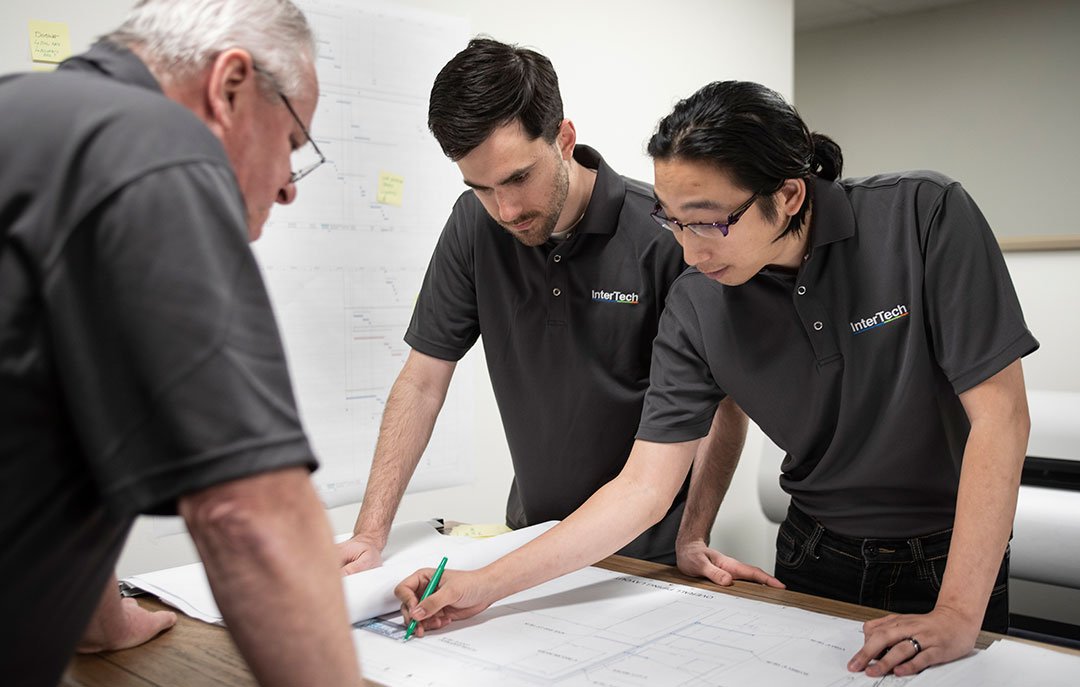Here at InterTech, we service the food and beverage industry with turn-key engineering solutions including process, packaging and utilities, along with related infrastructure modifications. In this article, we are going to focus on how pasteurizers work. More specifically, we are going to delve into how pasteurizers convert raw products into safe shelf-stable products.
This process is also known as commercial sterilization as defined in the Code of Federal Regulations (CFR), Title 21. According to the USDA, in order to be shelf-stable, “perishable food must be treated by heat and/or dried to destroy foodborne microorganisms that can cause illness or spoil food.”
Commercial sterilization in pasteurizers is a continuous closed system made up of:
- Heat exchangers to lift products to required temperatures
- Timing pumps for controlling product velocity and volume
- Hold tubes with lengths that allow products to be held at a specific temperature for a required amount of time
- Coolers that lower product temperatures for bottling
The rapid heating and cooling cycle associated with commercial sterilization helps to maintain food qualities such as flavor, nutrients, and color.
There are six key elements within a pasteurizer system:
- Product
- Flow
- Deaerating
- Temperature
- Hold Time
- Cooling
These six elements, along with product volume, instrumentation and automation allow a pasteurizer to convert raw products into safe shelf-stable products. The pasteurizer constitutes a critical control point (CCP), which means the product leaving the pasteurizer system must meet critical factors such as time and temperature before moving downstream to the filler. Products that do not meet the critical factors are diverted to reprocessing.
A typical path to commercial sterilization starts at the raw product tanks.
Pumps transfer the raw product from these tanks to a raw product balance tank. In simple sterilizing systems, a timing pump sends raw product from the balance tank through the pasteurizer (heater, hold tube, cooler) at a flow rate designed to achieve the required hold time.
Assuming all critical factors are achieved, commercially sterile product moves downstream to the filler. This is where volume becomes critical because the amount of product arriving at the filler has to fill containers at the rated speed of the filler while forcing air and foam out of the container. The portion of product used to purge air and foam is usually recovered and sent back to the pasteurizer system for reprocessing.
Pasteurizer designs can create versatile sterilizing systems that are configured to work with multiple products, speeds and container sizes. A pasteurizer is a CCP that impacts product safety, and can affect product quality and line performance.
It is important to understand how your pasteurizer was designed, how it works, and the key control factors.
I’d like to briefly touch on two key control factors: line speed and bottle changes.
Line Speed
Long after the pasteurizer has been designed, installed and commissioned, facilities will change the operating speed of the line. Sometimes this change is driven by formal programs where the organization expends resources to speed up the packaging line. Other times this change is driven by an individual line operator who decides to speed up the machine.
In both cases, the goal of increasing line speed may actually result in decreased overall line efficiency and yields if the change is not properly managed.
Pasteurizers are designed for specific package sizes and speeds.
As noted above, product volume through the hold tubes and out to the filler is critical. The pasteurizer is a steady state single speed unit designed to meet time and temperature requirements and match the designed filler demand for each specific package size.
In addition, the product recovery system is sized for a given line efficiency and other operational issues. The recovery system can buffer line changes and outages over short periods, but cannot absorb line changes over longer periods.
Changing filler operating parameters and bottle sizes impacts the operation. Changes can run tanks dry or fill them too fast. Uncontrolled line changes and reduced line efficiency cause longer outages, forcing the operation to dump product and run water. This reduces line yields and increases the cost per case out the door.
Bottle Changes
Market forces constantly drive new bottle designs and sizes. Operations is often asked to run the new bottle on existing lines. Like changing line speeds, there is an impact to line operations if the change is not properly managed.
For example, when a bottle size is reduced, the amount of product required at the filler is also reduced. Without pasteurizer changes, the amount of product being recovered and reworked increases.
This may have negative effects on the recovery side of the sterilization loop. A packaging line that has not increased line efficiency will find their tanks are filling too fast. Product builds up and cannot be processed into containers. Eventually, product will have to be dumped and the cost-per-case will rise.
At InterTech, we develop and implement plans that successfully change packaging line speeds and bottle sizes. If you have any questions about how pasteurizers work, please don’t hesitate to contact us. We are always here to help.
If you’d like to read more about this topic, please click over to Pasteurizer Problems Commonly Found in the Food and Beverage Industry.

Let us show you how InterTech will improve your operating efficiencies and increase your profitability
InterTech brings clients value by performing plant engineering services with integrity, skill and efficiency. Our specialty is working within existing facilities to optimize line design for space and efficiency.


0 Comments